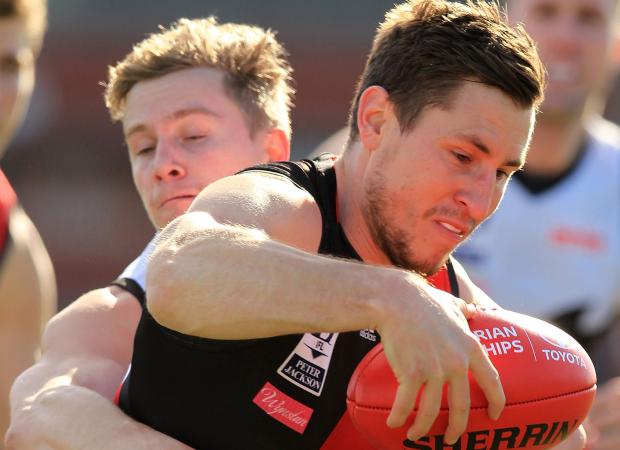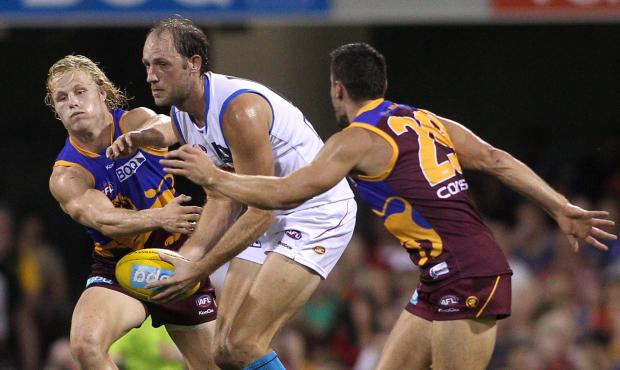THERE'S something not quite right about the Gold Coast and Brisbane Lions reserves teams.
The Lions are running last in the NEAFL, and despite a much-improved season on 2014, the Suns are fresh off a 130-point flogging at the hands of powerhouse AFL cousin Greater Western Sydney.
It's a complex issue, but the two Queensland clubs are suffering.
The simplest explanation is the injury toll to both clubs.
Both have endured horrendous seasons in the medical room, and the ripple effect to the reserves is directly proportionate.
Against the Giants in the NEAFL on Saturday, Gold Coast fielded just 11 AFL-listed players (including four rookies) up against a team fielding 19, including seven top-10 draft picks.
At the height of their injury crisis this season, the Lions have run out as few as six AFL-listed players in the NEAFL and have won just once in 13 matches.
Square pegs, round holes
The next issue comes from how the teams are topped up.
The NEAFL implemented new regulations this season to give AFL clubs priority access to four of their own under-18 academy players each week, where previously those players were farmed out to other clubs.
The four AFL clubs fielding teams in the NEAFL are now also allowed to play 20 AFL-listed players in the reserves, compared to last season's 18. However, that's not an issue the Queenslanders have been fortunate enough to confront this year.
Beyond the Suns' NEAFL core of AFL-listed players, the Suns draw top-up players from NEAFL affiliate Southport, while the Lions draw theirs from Redland.
However, both Southport and Redland get first call on their players for their NEAFL senior teams, effectively leaving the Suns and Lions to top up with NEAFL reserves players, and not necessarily in the positions the AFL clubs require.
How is the situation different to clubs in traditional AFL states?
In some states it's similar and in others it's worlds apart, but in most cases, those AFL-listed players from clubs in Victoria, SA and WA who aren't picked to play seniors generally get a far better hit-out than their NEAFL cousins.
Adelaide and Port Adelaide have standalone reserves teams running around in the SANFL, though both source top-up players.
The Crows get their top-ups from a development squad picked at the start of the season, while Port Adelaide offers SANFL contracts to 15 promising youngsters from the club's academy side.
Each also has a seasoned, non-AFL-listed captain.
After a partial alignment in 2013, West Coast (with East Perth) and Fremantle (with Peel Thunder) went to a full alignment in the WAFL in 2014.
The strength of the competition is evident by how the Eagles and Dockers are used when they play in the state league competition.
Alex Silvagni has made his way back from injury through the Peel reserves, while Tom Barrass – who is likely to make his debut for the Eagles this weekend – was playing for East Perth's reserves until 10 weeks ago after being drafted in 2013.
These are established WAFL clubs being supplemented by AFL-listed players – not AFL-listed players being topped-up by WAFL cast-offs.
Victorians clubs have a mix of those two systems in the VFL.
Collingwood, Essendon, Geelong, Richmond and the Western Bulldogs have standalone reserves teams in the VFL, while the other five clubs have affiliations similar to those of the WAFL clubs.
Standalone clubs are allowed to maintain a separate list of top-up players to fill out their VFL teams.
Former Lion James Polkinghorne is among the ex-AFL players on Essendon's VFL list. Picture: AFL Media
AFL clubs want development, state league clubs want a premiership
The NEAFL is aware of the imbalances, but it's a difficult fix.
"Everything we do, we balance the needs of the AFL clubs and those of the state league clubs," AFL national second-tier manager Simon Laughton said.
"AFL clubs want to develop their talent, and state league clubs want to know they have a fair chance of winning a premiership."
Gold Coast's NEAFL coach Josh Fraser said the current system made things difficult for the club to develop players.
"The access of mature talent is just not there for us, so when we reach a threshold of under 15 listed players, we're vulnerable to those defeats," Fraser said in relation to the heavy loss to the Giants last weekend.
"I don't see these [top-up] kids a lot, so I'm not exposed to what they can and can't do. I just see them on the weekend against a mature side … they're not physically ready to compete at that level."
The flow-on effect is dramatic.
On Saturday Jack Martin played his first game back from a six-week hamstring injury, but so weak was the Suns' midfield, it was hard to monitor his playing time like they usually would.
It's unfair – and against a duty of care, says Fraser – to play the top-ups for prolonged time against physically more mature midfielders.
Impressive youngster Henry Schade was trying to hold up a defensive 50 copping a tsunami of forward entries – how do you evaluate his game?
"We have to keep in check the expectations on our listed players," Fraser said. "It's not helping their development; it's hindering it, if anything."
Josh Fraser knows the challenges facing the Suns after finishing his career there. Picture: AFL Media
A sustainable way forward
So, what's the solution?
Laughton says a mid-year chat with NEAFL clubs has the ball rolling and they'll hope to implement something new during the off-season.
"We've got to continually balance the needs of both parties and we're looking at ways to better support AFL clubs, which might potentially give them greater access to mature top-ups," he said.
"It's just where they come from, how old they are and how they get on a list.
"For example, if a player is delisted or retires, can he stay on as captain of the twos?
"There's a lot we have to work through."
Some blame has to land with the Suns and Lions for the relative strength of their lists.
After a winless NEAFL season in 2014, Gold Coast made a conscious effort last off-season to strengthen its reserves' depth by recruiting mature-age talent like Raines, Keegan Brooksby, Josh Glenn and revelation Adam Saad as rookies.
GWS and the Sydney Swans also have superior academy talent at the moment – although the Lions are closing – leaving the Suns at another disadvantage.
But that's difficult for the NEAFL to legislate around.
One idea Fraser has suggested is to keep undrafted academy players at their club of origin.
"Maybe [the AFL clubs] could lock them away for two years as NEAFL players, so you get some consistency, you can develop them, work hands on and fit them in your system so it doesn't compromise your listed players too much," he said.
"I'd call it a supp (supplementary) list.
"We need to make sure what comes of it is not a band-aid solution and is going to be sustainable going forward.
"I don't know if there's a perfect solution to it, but there's got to be a better one."
Drafted as a rookie, Adam Saad has slotted seamlessly into Gold Coast's senior team. Picture: AFL Media




